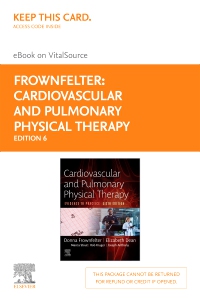
Cardiovascular and Pulmonary Physical Therapy Elsevier eBook on VitalSource (Retail Access Card), 6th Edition
Elsevier eBook on VitalSource - Access Card

Commensurate with an emphasis on evidence-based practice and health competencies to improve patient outcomes, give your students a solid foundation in cardiovascular and pulmonary physiology and rehabilitation! Cardiovascular and Pulmonary Physical Therapy: Evidence and Practice, 6th Edition provides a holistic, person-centered approach to the spectrum of cardiovascular and pulmonary physical therapy. From examination and evaluation to interventions, this book guides students through the health promotion strategies for maximizing patients’ health and wellbeing, in conjunction with managing the needs of patients with acute and chronic conditions, those in intensive care units, and of special populations such as children and elders. Selected case studies translate related scientific research into evidence-based practice and enhance clinical decision making. Now including an enhanced eBook version (with print purchase), this text details the latest best practices to help achieve the best physical therapy outcomes.
-
- NEW! Updated content reflects the latest research and clinical practice in the field.
- NEW! eBook version included only with print purchase allows students to access all the text, figures, and references, with the ability to search, customize their content, make notes and highlights, and have content read aloud.
- NEW! Video clips, interviews with authors and other experts in their fields, and more are available in the eBook version included only with print purchase.
- Coverage of evidence-based practice includes the latest research from leading top-tier journals to support physical therapist clinical reasoning and decision making.
- Realistic scenarios and case examples show the application of concepts to evidence-based practice.
- Holistic approach supports treating the whole person rather than just the symptoms of a disease or disorder, covering medical, physiological, psychological, psychosocial, therapeutic, practical, and methodological aspects.
- Full-color photos and illustrations enhance student understanding of the book's concepts, ideas, and management considerations.
- Emphasis on the terminology and guidelines of the APTA's Guide to Physical Therapist Practice keeps the book consistent with the practice standards in physical therapy, including the International Classification of Functioning, Disability and Health.
- Primary and secondary cardiovascular and pulmonary conditions are emphasized, along with their co-existence.
- Multimorbidity focus is used rather than a single-disease framework, with attention to implications for assessment, management, and evaluation.
- Integrated approach to oxygen transport demonstrates how the cardiovascular and pulmonary systems function interdependently to support all organ systems.
- Key terms and review questions in each chapter focus student learning on important concepts and translating these into practice.
-
- NEW! Updated content reflects the latest research and clinical practice in the field.
- NEW! eBook version included only with print purchase allows you to access all the text, figures, and references, with the ability to search, customize your content, make notes and highlights, and have content read aloud.
- NEW! Video clips, interviews with authors and other experts in their fields, and more are available in the eBook version included only with print purchase.
- NEW! Expanded contributions from experts from multiple countries maximize the validity of content.
-
Part I: Cardiovascular and Pulmonary Function in Health and Disease
1. Epidemiology as a Basis for Informing Contemporary Physical Therapist Practice
2. Cardiovascular and Pulmonary Function in Health
3. Cardiovascular and Pulmonary Function in Disease
4. Psychosocial Aspects of Health Status
Part II: Cardiovascular and Pulmonary Physical Therapy: Cardiopulmonary Assessment
5. Measurement, Documentation, and Clinical Decision Making
6. History
7. Pulmonary Function Tests
8. Arterial Blood Gases
9. Imaging of the Chest
10. Electrocardiogram Identification and Interpretation
11. Multisystem Assessment and Laboratory Investigations
12. Cardiopulmonary Invasive and Non-invasive Tests
13. Clinical Assessment and Evaluation of the Cardiovascular and Pulmonary Systems
14. Clinical Assessment and Evaluation of Psychosocial Status
Part III: Cardiovascular and Pulmonary Physical Therapy: Interventions
15. Maximizing Outcomes: Relating Interventions to an Individual's Needs
16. Psychosocial Interventions to Augment Outcomes
17. Mobilization and Exercise: Physiologic Bases for Assessment, Evaluation and Training
18. Mobilization and Exercise: Testing and Training
19. Body Positioning
20. Facilitating Airway Clearance
21. Facilitating Ventilation Patterns and Breathing Strategies
22. Exercise Testing and Training: Cardiovascular and Pulmonary Dysfunction
23. Respiratory Muscle Training
24. Integrative Therapies as Cardiovascular and Pulmonary Physical Therapy Interventions
25. Patient Education
Part IV: Cardiovascular and Pulmonary Physical Therapy: Acute and Chronic Conditions
26. Individuals with Acute Medical Conditions and Surgical Conditions
27. Individuals with Chronic Primary Cardiovascular and Pulmonary Dysfunction
28. Individuals with Chronic Secondary Cardiovascular and Pulmonary Dysfunction
Part V: Cardiovascular and Pulmonary Physical Therapy: Intensive Care
29. Monitoring Systems, Catheters, and Devices in the Intensive Care Unit
30. Comprehensive Management of Individuals in the Intensive Care Unit
31. Intensive Care Management of Medical and Surgical Complications
Part VI: Cardiovascular and Pulmonary Physical Therapy: Special Cases
32. Infants and Children with Cardiovascular and Pulmonary Dysfunction
33. The Older Adult
34. Multisystem Clinical Implications of Impaired Breathing Mechanics and Postural Control
35. The Transplant Patient
36. The Patient in the Community
Part VII: Related Aspects of Cardiovascular and Pulmonary Physical Therapy
37. Body Mechanics: Positioning and Moving Patients
38. Respiratory Care Practice Review
39. Care of the Patient with an Artificial Airway


 as described in our
as described in our 